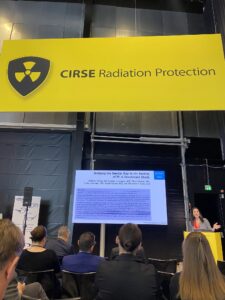
The Cardiovascular and Interventional Radiological Society of Europe (CIRSE) 2023 annual meeting (9–13 September, Copenhagen, Denmark) hosted sessions dedicated to radiation protection, contemporary risk management strategies for staff and patients, and challenges faced by interventional radiologists in the developing world. Among key takeaways across Sunday and Monday of the meeting was the assertion that optimisations for radiation mitigation must be implemented universally, although “steps should be taken by national and international institutions” to ensure these needs are met so that radiation exposure no longer represents a deterrent to entering the field of interventional radiology (IR).
Radiation protection for interventional radiologists in developing countries with resource-limited facilities
Presenting in Sunday’s ‘Radiation protection: a worldwide challenge’ session, Gabriel Bartal (Tel Aviv University, Tel Aviv, Israel) began by situating his focus in Africa, where he asserted problems in radiation protection are “most prominent” today. Providing an overview of the current measures in place in these countries, Bartal stated first that “IR has changed clinical medicine worldwide”, however “incorporation of IR methodologies in these countries is much behind where is desired, if at all”.
Aiming to improve conditions, Bartal referenced the International Atomic Energy Agency’s (IAEA) multinational prospective study which surveyed 55 hospitals in 20 low-resource nations, reporting that workloads have doubled in 30% of countries within the last three years. Kerma-area product (KAP) measures were only available in half of the institutions included, and “none” of the surveyed clinicians stated prior experience with its use. To Bartal, these data display the “requirement of more certified interventional radiologists, radiation protection and training”, to meet the “rising” demand for image-guided interventions in African countries.
Addressing strategies to improve radiation protection conditions in Africa, Bartal described a survey conducted by Wilbroad Muhogora (Tanzania Atomic Energy Commission, Arusha, Tanzania) et al, which reported that lead aprons are used in all participating African hospitals. However, only 44% reported the additional use of lead goggles. In concurrence with Muhogora et al’s findings, Bartal reiterated that, although optimisation steps have been taken, challenges faced by interventional radiologists in low-resource settings are “incomparable” to high-income countries, concluding that efforts to implement further safety measures and collect crucial maintenance data must be bolstered by international IR societies.
Meanwhile, he stated that several leading interventional radiologists from North America and Europe are training radiologists from several African countries on site, to safely perform complex interventional procedures. Of his final thoughts, Bartal stated that voluntarily assisting IR training worldwide is “the way to make sure that the patients will undergo minimally invasive procedures without complications and without needing lengthy hospitalization—interventional radiologists are encouraged to join these valuable efforts via www.Road2IR.org”, Bartal concluded.
Does low dose always mean low radiation?
Eliseo Vano (San Carlos University Hospital, Madrid, Spain) gave his presentation in Monday’s session titled ‘Protecting yourself, protecting your staff!’, describing the links between occupational and patient radiation doses in IR, and in what circumstances low dose procedures may involve high exposure for clinicians.
Central to his discussion was the relationship between procedural radiation dose and exposure to the clinician. Vano stated that understandably high patient doses involve a high level of scatter radiation, which inevitably increases occupational exposure. However, in low patient dose procedures—which he noted are “usually the most frequent”—occupational doses may remain high if “protection tools are not used properly”.
To this end, Vano emphasised the importance of communication around radiation protection to the CIRSE audience, which, if compromised, should be “alerted, corrected and discuss[ed] in training sessions”. Furthering his proposal for dose mitigation, the speaker asserted that an audit of occupational doses should be made monthly, referring to a study he led that described the added importance of dose management systems (DMS) when auditing dose more closely over time.
In their study, Vano et al collected data from C-arm dosimeters in five international IR facilities, surveying patient dose indicators, occupation dose values, the ratio between occupational doses, and the doses measured by the reference dosemeter at the C-arm, and the ratio between occupational and patient dose values.
Among the 4,500 procedures and 8,000 records of occupational exposures included within their review, Vano and colleagues note that patient and staff dose data was available for 3,043 procedures, which the investigators positively conclude provides an “advantage”, integrating both staff and patient dose for a clearer outlook on procedural exposure. Finalising his presentation, Vano added that implementation of sensitised alerts should be central to future education programmes for interventional radiologists.
The IR gender gap: Mitigating radiation hazard perception
Opening her presentation, Maureen Kohi (University of North Carolina, Chapel Hill, USA) described a prospective online survey carried out by CIRSE evaluating the gender gap in IR and the barriers facing women trainees specifically. “There is a paucity of women in IR in CIRSE and around the world,” Kohi noted, foregrounding a key and perhaps influential finding from the survey which pointed to women’s concern about radiation, particularly during pregnancy.
However, Kohi made clear that concern over radiation exposure is not singularly attributed to women—referencing a survey carried out by Yarelis Vazquez Perez (University of Maryland, Baltimore, USA) et al, she drew attention to the equal percentage of male and female respondents who rated radiation exposure as a the main deterrent to pursuing a career in IR. “Men are also worried about radiation exposure—it is not unique to the female sex,” Kohi continued, but “as females are the only sex that can be pregnant, it is a big concern during this time”.
“But what do we know about occupational radiation exposure?” Kohi asked the CIRSE 2023 audience, briefly describing the variations that exist in regulations concerning occupational radiation exposure during pregnancy. Currently, in the USA, maximum foetal dose is set at five millisieverts (mSv), although in Europe this limit is 1mSv. “But when you look at more data,” Kohi expands—referencing a study conducted by Stephane Manzo-Silberman (Pitié-Salpêtrière Hospital, Paris, France) and colleagues—“and you look at the dose that would be required to cause [prenatal] effects, we are so beneath that threshold”. To this Kohi emphasised Manzo-Silberman et al’s finding which marked 100mGy of radiation as the occupational dose threshold after which foetal effects were reported.
“The theory exists, but it is virtually not possible,” Kohi averred, to which she reiterated that “radiation exposure should not be a barrier for female or male trainees in becoming interventional radiologists”. Concluding, Kohi underlined that education is needed for female trainees on the safety of prenatal radiation exposure. She stated: “We need to mentor our pregnant female trainees so that they are not afraid—we want these women to continue their career while pregnant.”










